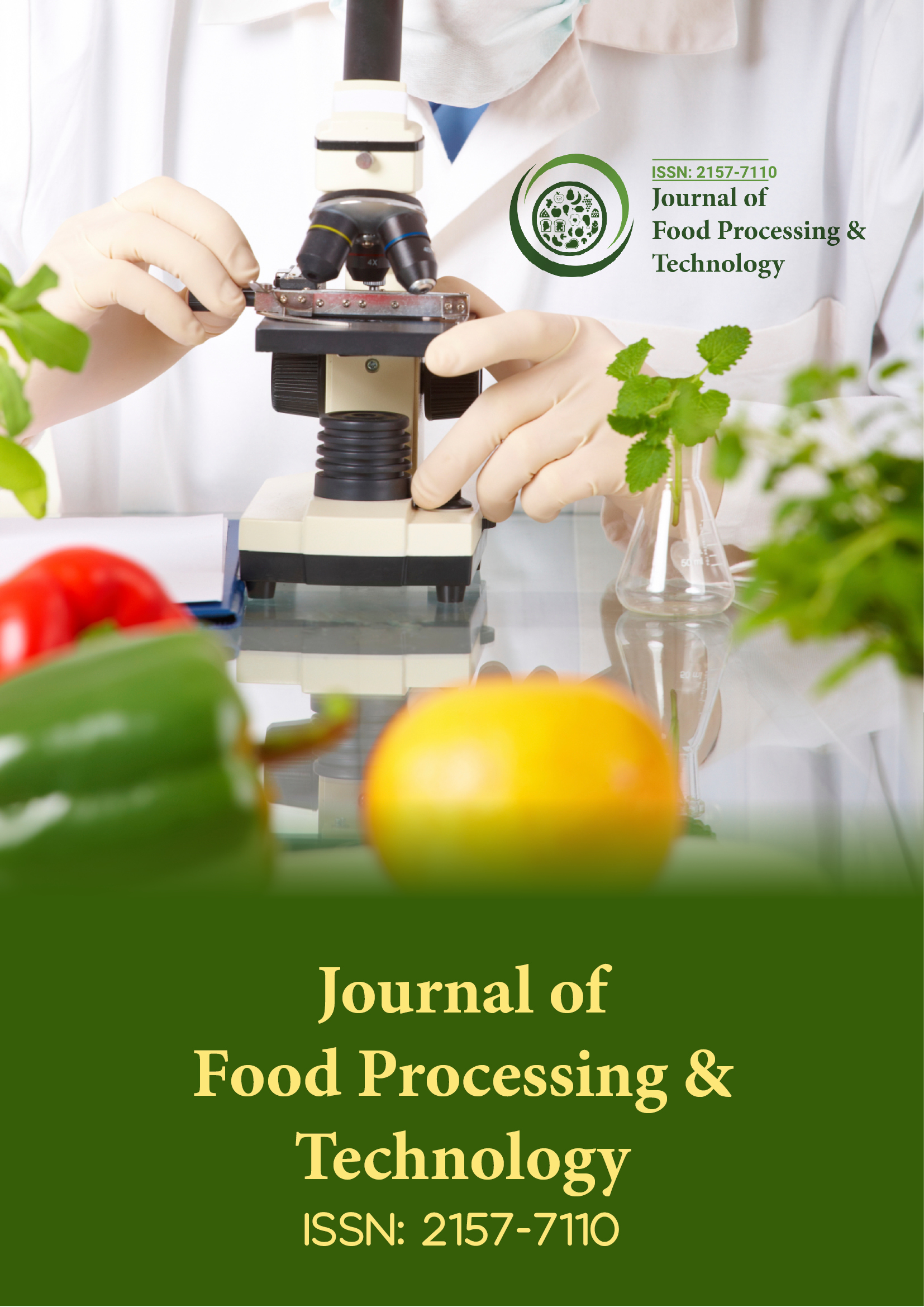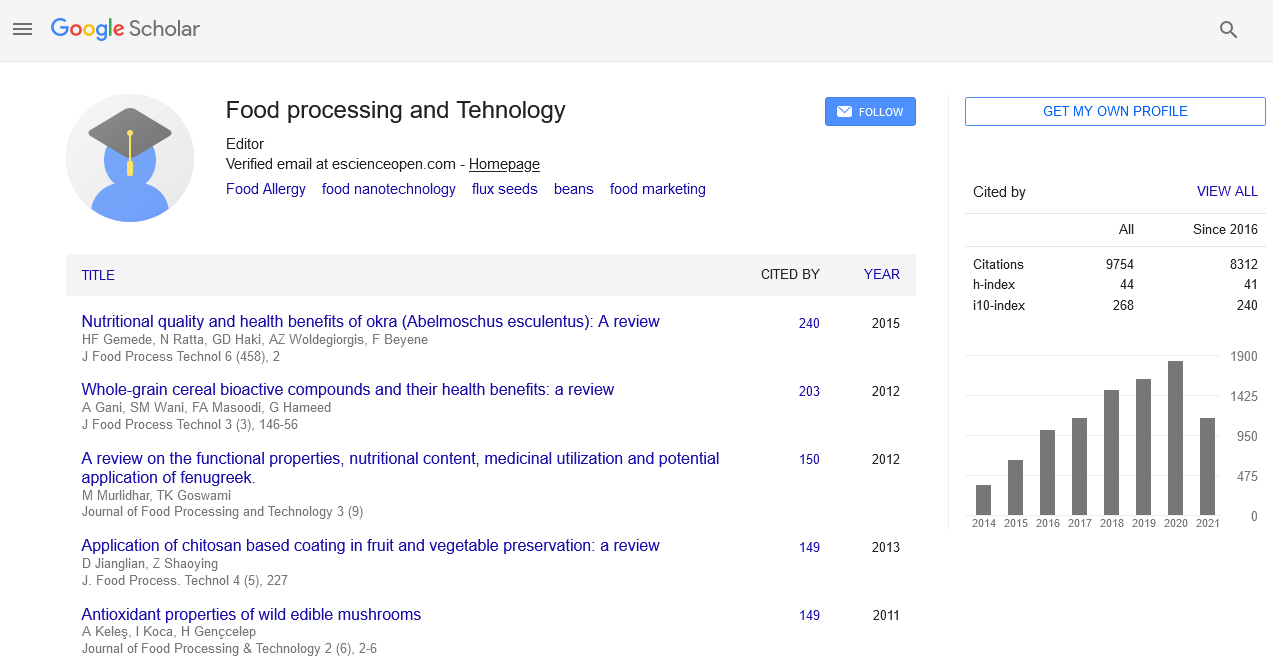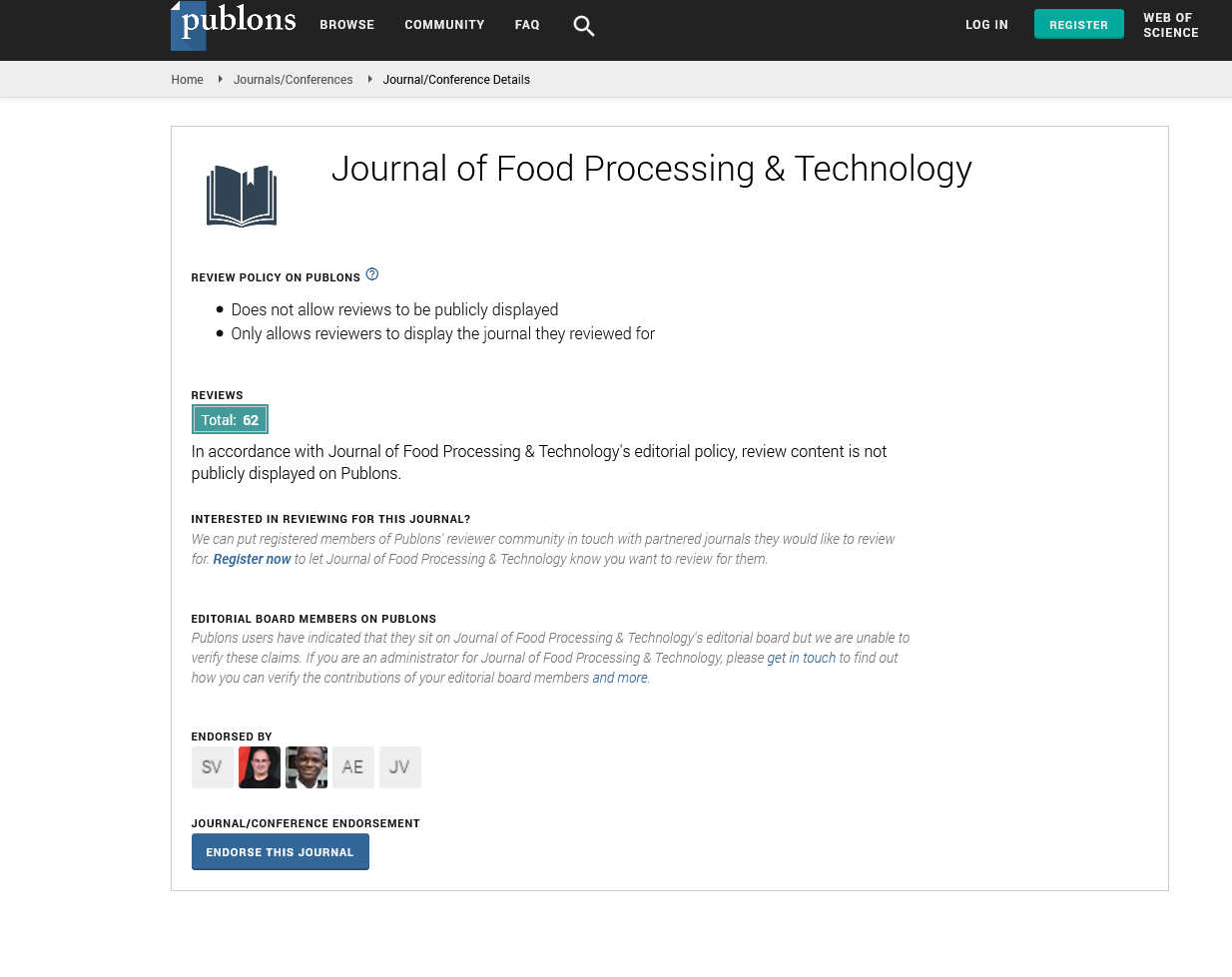Indexed In
- Genamics JournalSeek
- Academic Keys
- JournalTOCs
- China National Knowledge Infrastructure (CNKI)
- Access to Global Online Research in Agriculture (AGORA)
- Centre for Agriculture and Biosciences International (CABI)
- RefSeek
- Directory of Research Journal Indexing (DRJI)
- Hamdard University
- EBSCO A-Z
- OCLC- WorldCat
- Scholarsteer
- SWB online catalog
- Publons
- Euro Pub
- Google Scholar
Useful Links
Share This Page
Journal Flyer

Open Access Journals
- Agri and Aquaculture
- Biochemistry
- Bioinformatics & Systems Biology
- Business & Management
- Chemistry
- Clinical Sciences
- Engineering
- Food & Nutrition
- General Science
- Genetics & Molecular Biology
- Immunology & Microbiology
- Medical Sciences
- Neuroscience & Psychology
- Nursing & Health Care
- Pharmaceutical Sciences
Perspective - (2025) Volume 16, Issue 3
High-Pressure Processing for Extending the Shelf Life of Fresh Juices
Sophie Martin*Received: 26-May-2025, Manuscript No. JFPT-25-29653; Editor assigned: 28-May-2025, Pre QC No. JFPT-25-29653; Reviewed: 11-Jun-2025, QC No. JFPT-25-29653; Revised: 19-Jun-2025, Manuscript No. JFPT-25-29653; Published: 25-Jun-2025, DOI: 10.35248/2157-7110.25.16.1163
Description
Fresh fruit and vegetable juices are widely appreciated by consumers for their natural flavor, vibrant color and rich nutritional content. They provide essential vitamins, minerals and bioactive compounds such as polyphenols, carotenoids and antioxidants, which contribute to overall health and wellness. However, these beverages are highly perishable due to their high water activity, nutrient density and neutral pH, which create an ideal environment for microbial growth. Spoilage microorganisms, including yeasts, molds and bacteria, can rapidly degrade the quality of juices, resulting in off-flavors, color changes and potential health hazards. To ensure consumer safety and extend shelf life, preservation techniques are necessary. Traditionally, thermal pasteurization has been employed to inactivate spoilage and pathogenic microorganisms in juices. Heat treatment effectively reduces microbial load and extends shelf life, but it comes at a cost. High temperatures can significantly alter the sensory characteristics of juices, including taste, aroma and color, leading to a less fresh-like product. Moreover, heat-sensitive nutrients such as vitamin C, certain B vitamins and polyphenols are often partially or completely degraded during thermal processing, reducing the nutritional value of the juice. These limitations have prompted the food industry to explore alternative preservation technologies that maintain both safety and quality.
High-Pressure Processing (HPP) has emerged as a promising nonthermal preservation technique for fruit and vegetable juices. In HPP, packaged juices are subjected to extremely high hydrostatic pressures, typically ranging from 300 to 600 Mega Pascals (MPa). This intense pressure disrupts the cellular structure of microorganisms, effectively inactivating bacteria, yeasts and molds without the need for high temperatures. Since the pressure is applied uniformly and instantaneously, it penetrates the product evenly, ensuring microbial inactivation throughout the entire volume. Unlike thermal pasteurization, HPP preserves natural flavors, colors and heat-sensitive nutrients, producing juices that closely resemble freshly squeezed varieties. One of the key advantages of HPP is its ability to maintain the integrity of vitamin C, an essential nutrient highly susceptible to heat degradation. In addition, other antioxidants and polyphenolic compounds are better preserved, enhancing the functional and nutritional quality of the juice. The retention of sensory attributes, including aroma, color and mouthfeel, further enhances consumer acceptance. Juices processed via HPP are often described as fresh-like, with vibrant color and authentic flavor profiles, making them particularly appealing in premium and cold-pressed juice markets.
Commercial adoption of high-pressure processing has expanded rapidly over the past decade. Many juice brands now utilize HPP to meet consumer demand for minimally processed, clean-label beverages. The technology allows producers to offer products free from preservatives while maintaining safety and extended shelf life. The process is also compatible with a variety of fruit and vegetable combinations, including orange, apple, carrot, beetroot and mixed green juices. Packaging is a critical consideration in HPP, as the process requires flexible, highstrength materials that can withstand extreme pressure without rupturing. Common packaging options include pouches, PET bottles and multilayer plastics designed specifically for highpressure applications. Although HPP equipment represents a significant capital investment, its economic benefits can outweigh costs, particularly for high-value products. By extending shelf life and reducing spoilage, HPP enables broader distribution and reduces waste, providing both financial and environmental advantages. Additionally, the ability to produce fresh-like juices aligns with current market trends, as consumers increasingly seek healthy, natural and minimally processed foods. This alignment enhances brand value and market competitiveness, making HPP an attractive option for juice manufacturers.
Ongoing research is focused on optimizing HPP parameters, including pressure intensity, duration and temperature conditions, to maximize microbial inactivation while preserving quality. Synergistic approaches, such as combining HPP with natural antimicrobial compounds or mild heat, are being explored to further enhance safety and stability. Moreover, researchers are investigating applications beyond fruit and vegetable juices, including smoothies, plant-based milks, functional beverages and even ready-to-eat meals, highlighting the versatility of HPP in modern food processing. In conclusion, high-pressure processing represents a transformative approach to juice preservation, offering a balance between microbial safety and the retention of sensory and nutritional quality. By inactivating pathogens and spoilage microorganisms without compromising flavor, color, or nutrient content, HPP delivers fresh-like juices with extended shelf life. Its adoption in the beverage industry addresses both consumer demand for natural, minimally processed products and the need for safe, high-quality offerings. As technology advances and industrial adoption continues, HPP is likely to become a standard preservation method not only for fruit and vegetable juices but also for a wide range of perishable food and beverage products, shaping the future of the fresh beverage market.
Citation: Martin S (2025). High-Pressure Processing for Extending the Shelf Life of Fresh Juices. J Food Process Technol.16: 1163.
Copyright: © 2025 Martin S. This is an open access article distributed under the terms of the Creative Commons Attribution License, which permits unrestricted use, distribution and reproduction in any medium, provided the original author and source are credited.


